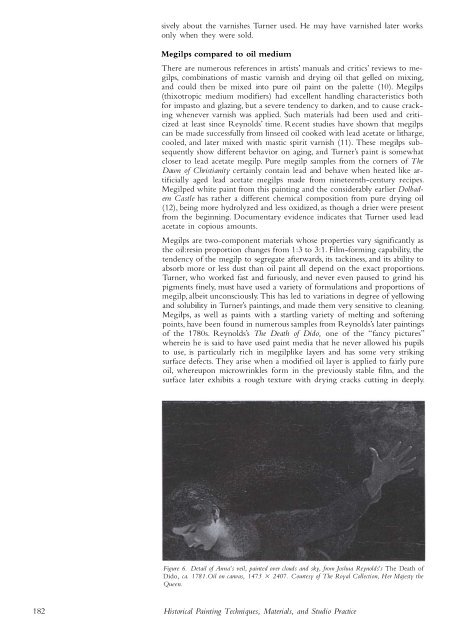Historical Painting Techniques, Materials, and Studio Practice
You also want an ePaper? Increase the reach of your titles
YUMPU automatically turns print PDFs into web optimized ePapers that Google loves.
sively about the varnishes Turner used. He may have varnished later works<br />
only when they were sold.<br />
Megilps compared to oil medium<br />
There are numerous references in artists' manuals <strong>and</strong> critics' reviews to megilps,<br />
combinations of mastic varnish <strong>and</strong> drying oil that gelled on mixing,<br />
<strong>and</strong> could then be mixed into pure oil paint on the palette (10). Megilps<br />
(thixotropic medium modifiers) had excellent h<strong>and</strong>ling characteristics both<br />
for impasto <strong>and</strong> glazing, but a severe tendency to darken, <strong>and</strong> to cause cracking<br />
whenever varnish was applied. Such materials had been used <strong>and</strong> criticized<br />
at least since Reynolds' time. Recent studies have shown that megilps<br />
can be made successfully from linseed oil cooked with lead acetate or litharge,<br />
cooled, <strong>and</strong> later mixed with mastic spirit varnish (11). These megilps subsequently<br />
show different behavior on aging, <strong>and</strong> Turner's paint is somewhat<br />
closer to lead acetate megilp. Pure megilp samples from the corners of The<br />
Dawn of Christianity certainly contain lead <strong>and</strong> behave when heated like artificially<br />
aged lead acetate megilps made from nineteenth-century recipes.<br />
Megilped white paint from this painting <strong>and</strong> the considerably earlier Dolbadern<br />
Castle has rather a different chemical composition from pure drying oil<br />
(12), being more hydrolyzed <strong>and</strong> less oxidized, as though a drier were present<br />
from the beginning. Documentary evidence indicates that Turner used lead<br />
acetate in copious amounts.<br />
Megilps are two-component materials whose properties vary significantly as<br />
the oil:resin proportion changes from 1:3 to 3:1. Film-forming capability, the<br />
tendency of the megilp to segregate afterwards, its tackiness, <strong>and</strong> its ability to<br />
absorb more or less dust than oil paint all depend on the exact proportions.<br />
Turner, who worked fast <strong>and</strong> fu riously, <strong>and</strong> never even paused to grind his<br />
pigments finely, must have used a variety of fo rmulations <strong>and</strong> proportions of<br />
megilp, albeit unconsciously. This has led to variations in degree of yellowing<br />
<strong>and</strong> solubility in Turner's paintings, <strong>and</strong> made them very sensitive to cleaning.<br />
Megilps, as well as paints with a startling variety of melting <strong>and</strong> softening<br />
points, have been fo und in numerous samples from Reynolds's later paintings<br />
of the 1780s. Reynolds's The Death if Dido, one of the "fancy pictures"<br />
wherein he is said to have used paint media that he never allowed his pupils<br />
to use, is particularly rich in megilplike layers <strong>and</strong> has some very striking<br />
surface defects. They arise when a modified oil layer is applied to fairly pure<br />
oil, whereupon microwrinkles form in the previously stable film, <strong>and</strong> the<br />
surface later exhibits a rough texture with drying cracks cutting in deeply.<br />
Figure 6. Detail if Anna's veil, painted over clouds <strong>and</strong> sky, from Joshua Reynolds's The Death of<br />
Dido, ca. 1781. Oil on cal1vas, 1473 X 2407. Courtesy of The Royal Collection, Her Majesty the<br />
Queen.<br />
182<br />
<strong>Historical</strong> <strong>Painting</strong> <strong>Techniques</strong>, <strong>Materials</strong>, <strong>and</strong> <strong>Studio</strong> <strong>Practice</strong>


